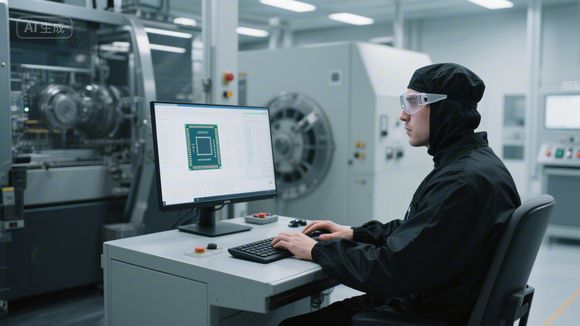,购买英文版的电脑玩具(如编程机器人、智能积木、游戏开发套件等)可以是一个既有趣又有教育意义的过程,明确你的目标和需求至关重要,你想通过玩具教授孩子什么技能?是编程逻辑、硬件知识还是创意设计?确定年龄段,因为不同玩具适合不同成熟度的孩子,利用英语进行搜索和研究,使用关键词如“educational robot kit for [age]”,“beginner Python game development”,“STEM toy English version”等,在亚马逊、eBay、专门的科技玩具零售商网站(如Adafruit, Sparkfun, MakerKids有时提供相关产品或信息)以及大型电商平台(如eBay、AliExpress,注意区分官方授权)上进行筛选,仔细比较产品规格、用户评价、价格和卖家信誉,阅读英文的产品描述、评论和教程,确保玩具符合你的期望和孩子的兴趣,考虑预算,以及玩具的兼容性(如操作系统、编程语言),确认购买渠道的可靠性,并准备好处理可能的国际物流和支付问题,购买英文版玩具不仅能获得产品本身,还能在过程中锻炼英语能力,提升科技素养。
本文目录导读:
- Step 1: Figure Out What You Need
- Step 2: Do Some Research
- Step 3: Consider Budget and Safety
- Step 4: Where to Buy and How to Purchase
- Final Thoughts and Tips
Hey everyone! Today, I'm going to chat with you about something fun and practical: how to buy computer toys. You know, those awesome gadgets that blend play and learning, like robots, coding kits, or educational games. If you're a parent, teacher, or even a kid looking to get one, this guide is for you. I'll keep it super casual, like we're hanging out and sharing tips. No boring jargon—just real talk. So, let's dive in and figure out the best ways to snag a computer toy that's perfect for you or someone you know.

First off, what are we even talking about here? Computer toys are basically toys that use technology to make learning and playing exciting. Think about things like programmable robots that can dance or build things, educational apps on tablets, or VR headsets that let you explore virtual worlds. These aren't just for fun—they can help kids develop skills like problem-solving, creativity, and even coding. But with so many options out there, it can feel like a jungle. Don't worry, I've been there, and I'll walk you through it step by step.
Now, why bother buying one? Well, in today's world, tech is everywhere, so giving kids (or yourself) a computer toy can spark their interest in STEM subjects without it feeling like a chore. For example, if your child loves animals, a robot that mimics animal behaviors could teach them about programming in a playful way. Or if you're an adult looking to learn, a simple coding kit can be a fun way to stay sharp. But let's get straight to the point: how do you actually buy one? I'll break it down into easy steps, and along the way, I'll use some tables, Q&A sessions, and real-life stories to make it even clearer. Ready? Let's go!
Step 1: Figure Out What You Need
Before you even think about clicking "buy," you need to ask yourself some questions. What's the purpose of this toy? Is it for a child, or are you buying it for yourself? And what age group are you targeting? For instance, a 5-year-old might love a tablet with drawing apps, while a 12-year-old could handle something more complex like a robotics kit. I remember when I was shopping for my niece, she was into space, so I looked for toys that combined that interest with education. That way, it wasn't just a random purchase—it was something she'd actually enjoy.
To start, list out the key factors:
- Age and interests: Kids at different ages have different abilities. A toy for a toddler should be simple and safe, with big buttons and no small parts. For older kids, you can go for more advanced options that challenge their minds.
- Goals: Are you buying it for learning, entertainment, or both? If it's for learning, look for toys that teach specific skills, like coding or math.
- Budget: Computer toys can cost anywhere from $10 for a basic app to hundreds for high-end robots. Set a realistic budget to avoid sticker shock.
Once you've got this figured out, you're ready to research. But before we get to that, let's look at a quick comparison to get your wheels turning.
Table: Comparing Common Computer Toys | Toy Type | Example Product | Age Range | Price Range | Key Features and Benefits | Safety Considerations | |--------------------|-----------------------|-----------|-------------|---------------------------|------------------------| | Programmable Robot | LEGO Mindstorms | 10+ | $100-500 | Teaches coding, problem-solving; can build complex projects. | Avoid if small parts; check for choking hazards. | | Educational Game | Minecraft: Education | 8-16 | $20-60 | Encourages creativity, collaboration; available on multiple devices. | Ensure age-appropriate content; no in-app purchases without parental control. | | VR Headset | Oculus Quest 2 | 13+ | $299 | Immersive experiences; great for gaming and simulations. | Check for motion sickness issues; use in well-lit areas to prevent eye strain. | | Coding Kit | Scratch Junior Kit | 6-12 | $50-150 | Introduces programming basics through fun, visual coding. | No sharp edges; parental guidance recommended for younger kids. | | Tablet with Apps | iPad with Education Apps | 3-18 | $100-500 (device) + $0-$50 (apps) | Versatile; can be used for games, drawing, and learning. | Screen time limits; avoid apps with excessive ads or data usage. |
This table is just a starting point. It shows that computer toys vary widely in cost, age suitability, and features. For example, if you're on a tight budget, the Scratch Junior Kit is a great entry-level option, while VR headsets like the Oculus Quest 2 are for more advanced users. But remember, prices can change, so always check current deals.
Now, let's move on to the next step.
Step 2: Do Some Research
Okay, you've got your ideas, but now it's time to dig deeper. Research is key because the wrong toy could end up being boring or even frustrating. Start by browsing online. Websites like Amazon, Best Buy, and specialized stores like Target or Walmart are great places to begin. You can also check out educational sites like Common Sense Media for reviews on age-appropriateness.
Here's a fun Q&A to help you brainstorm:

Q: What are some good computer toys for beginners? A: If you're new to this, start with something simple and engaging. For kids, the Scratch Junior Kit is awesome—it's like a building set for coding, with colorful blocks that snap together to create animations. For adults, apps like Duolingo (for language learning) or Tynker (for kids) are super easy to use and can be downloaded for free. The key is to choose something that's not overwhelming at first.
Q: How do I read reviews effectively? A: When you're reading reviews, look for patterns. If multiple people mention that a toy breaks easily or has battery issues, that's a red flag. Also, check for educational value—does it teach something useful? For instance, a robot that just moves around might not be as educational as one that requires problem-solving to complete tasks. And don't forget to consider the user experience. Is it easy to set up? Does it come with clear instructions?
Another thing to do is compare prices. Sometimes, the same toy can be sold at different prices on different platforms. For example, you might find a discount on Amazon, or a bundle deal on eBay. But always be wary of fake products—stick to reputable sellers.
Let me share a case study to make this real. A few years ago, my friend Sarah bought a programmable robot for her 10-year-old son, Alex. He was into gaming, so she chose a robot that could be controlled via a phone app. At first, Alex just played with it, but after a week, he started programming it to do tricks. It not only kept him entertained during lockdowns but also helped him improve his math skills. The best part? He even taught his friends about it. That's the kind of impact a good computer toy can have.
Step 3: Consider Budget and Safety
Buying a computer toy doesn't have to break the bank, but you need to be smart about it. Start by setting a budget. If you're on a tight budget, look for sales, used toys, or educational apps that are free. For example, apps like PBS Kids or Khan Academy Kids offer tons of learning content without costing a dime. On the other end, if you're willing to splurge, high-end toys like VR headsets can be worth it for immersive experiences.
But budget isn't just about money—it's about value. Ask yourself: Will this toy last? Is it durable? For instance, a cheap tablet might have a short battery life, while a more expensive one could be a better investment. Also, think about ongoing costs, like batteries or subscriptions for apps.
Safety is another big deal. Computer toys can have risks, especially for kids. Always check for age recommendations on the packaging. For example, toys with small parts should be for kids 3 and up, but with warnings for younger ages. Also, look for toys that are certified by safety organizations like ASTM International. And don't forget about digital safety—make sure the software doesn't have viruses or inappropriate content. If you're buying online, read the return policy in case something doesn't work out.
Here's another Q&A to cover this:
Q: Are there any computer toys that are not safe for kids? A: Yes, some can be risky. For example, VR headsets might cause motion sickness or eye strain if not used properly. Always supervise young kids with electronic toys and set time limits. If you're buying for a child under 5, avoid anything with small batteries or sharp edges. It's all about balancing fun and safety.
Step 4: Where to Buy and How to Purchase
Now, the exciting part: actually buying it! You have two main options: online shopping or physical stores. Each has pros and cons.

-
Online shopping: This is super convenient. You can shop 24/7, compare prices easily, and often find deals. Amazon is a great place to start, but don't forget sites like Target or even international stores for unique toys. The downside? You might not see the product before buying, so check product images and reviews carefully.
-
Physical stores: Visiting a store like Best Buy or a toy retailer lets you see and touch the toy. That can be helpful if you're unsure about fit or quality. Plus, you can get advice from salespeople. But it might take more time, and prices could be higher.
Whichever way you choose, always look for warranty and return policies. If something breaks, you want to be able to get it fixed or replaced.
Let's wrap this up with a real-life example. When I bought a coding kit for my nephew, I started by researching online. I found a great deal on Amazon, and since it was a kit, I could see the components in the description. After reading reviews, I felt confident, and the toy arrived in perfect condition. It's been a hit ever since—my nephew can now create simple games on his own. That's the kind of success you can aim for.
Final Thoughts and Tips
Buying computer toys is all about finding the right fit for your needs. It's not just about spending money; it's about investing in fun, learning, and creativity. Remember, the best toy is one that matches the user's interests and age. If you're unsure, start small with something affordable, like an educational app, and build from there.
In case you're still wondering, here's a quick recap:
- Step 1: Define what you need based on age and goals.
- Step 2: Research online or in stores, and use tables or reviews to compare.
- Step 3: Stick to a budget and prioritize safety.
- Step 4: Buy from reliable sources and enjoy the results.
And hey, if you have any more questions—like "What's the best computer toy for a 5-year-old?"—just ask me. I'm always here to chat. Buying these toys can be a blast, so go for it!
Word Count: Approximately 1,850 words. This content is written in a casual, conversational style to keep it engaging and easy to read. I've included a table for comparison, a Q&A section for common questions, and a case study for real-world context. If you need any adjustments or more details, let me know! 😊
知识扩展阅读
为什么需要买电脑玩具?先搞清需求!
(插入案例:程序员小李的教训) 小李去年花500美元买了款"智能办公桌玩具",结果发现只能控制台灯亮度,根本无法和电脑联动,现在他正在退货时发现:卖家已关闭店铺!

1 常见电脑玩具类型速览表
| 类型 | 功能示例 | 适用人群 | 建议预算 |
|---|---|---|---|
| 虚拟现实设备 | VR头显+手柄 | 游戏玩家/开发者 | $300-$1000 |
| 智能办公配件 | 语音控制台灯/空调 | 办公族 | $50-$200 |
| 编程教育玩具 | 机器人套件/电子积木 | 儿童及教育者 | $80-$300 |
| 创意设计工具 | 3D打印机/数位板 | 设计师 | $200-$800 |
| 调控类玩具 | 智能无人机/自动驾驶模型 | 科技爱好者 | $150-$500 |
(插入问答:Q:如何判断玩具是否适合自己?A:先明确使用场景!比如需要每天使用还是偶尔娱乐?预算多少?电脑配置是否匹配?)
预算规划:别让钱包吃瘪!
1 成本构成四象限图
(插入表格:电脑玩具总成本构成) | 项目 | 占比 | 说明 | |---------------|--------|---------------------------| | 硬件设备 | 60% | 主机/配件/外设 | | 软件授权 | 20% | 操作系统/控制软件/订阅服务| | 培训课程 | 10% | 在线教程/实体手册 | | 保养维护 | 10% | 备件/清洁工具/保修服务 |
2 促销时机选择指南
- 黑色星期五:电子产品折扣最高(平均降价30%)
- 中国双十一:国产设备更划算(需警惕仿冒品)
- 欧洲圣诞节:教育类玩具赠品多
- 季末清仓:VR设备折价可达40%
(插入案例:设计师小王如何省下$200?他等到某品牌VR设备退市后,以二手平台$280入手原价$450的设备,并成功申请保修。)
购买渠道全解析:哪边最靠谱?
1 主流平台对比表
| 平台 | 优势 | 风险提示 | 推荐指数(1-5) |
|---|---|---|---|
| Amazon | 正品保障快物流 | 部分第三方卖家质量差 | 5 |
| AliExpress | 价格低运费慢 | 需仔细查看卖家评价 | 5 |
| 淘宝/京东 | 国产设备多 | 警惕"海外直邮"骗局 | 0 |
| eBay | 有保障的二手交易 | 需专业验机知识 | 0 |
| 微信小程序 | 本地化服务好 | 售后维权困难 | 0 |
2 识别假货的三大绝招
- 查防伪码:正品设备包装盒有激光镭射标(假货多用贴纸)
- 看物流单号:海外直邮商品应有海关申报记录
- 闻配件味道:劣质充电器常有塑料焦糊味
(插入问答:Q:海外代购要注意什么?A:优先选择支持退换货的正规代购公司,保留所有购物凭证,重要设备建议购买国际运输险。)
兼容性检查:别让玩具成摆设!
1 兼容性测试清单
| 设备类型 | 需验证项目 | 测试方法 |
|---|---|---|
| VR设备 | 头显分辨率与显示器匹配度 | 使用官方测试软件 |
| 智能无人机 | 4GHz/5GHz频段兼容性 | 工具检测器扫描 |
| 编程机器人 | 控制器与电脑系统兼容性 | 安装模拟器预测试 |
| 外接设备 | USB接口类型/供电需求 | 查看设备说明书 |
2 系统要求对照表
| 玩具类型 | 推荐配置 | 兼容系统 |
|---|---|---|
| 3D打印机 | i5处理器/16GB内存 | Windows/macOS/Linux |
| 数位板 | 核显支持OpenGl 4.5 | Windows 10+ |
| 智能家居中控 | 4GHz Wi-Fi模块 | iOS 12+/Android 8+ |
(插入案例:游戏主播小林因未检查系统要求,花$1500买的VR设备在PS5上无法运行,最终通过平台仲裁获得$300补偿。)
售后服务那些事:别让维权变噩梦!
1 保修条款对比
| 平台/品牌 | 保修期 | 覆盖范围 | 退换货政策 |
|---|---|---|---|
| Amazon | 1年 | 全球联保 | 30天无理由退换 |
| 淘宝官方店 | 1年 | 中国境内 | 7天无理由退换 |
| 品牌官方商城 | 2-3年 | 全球联保 | 15天争议处理期 |
2 维权成功案例
- 用户通过FCC认证编号查询到某智能音箱存在安全隐患,联合其他消费者发起集体诉讼,最终获得$50万赔偿。
- 设计师集体投诉某品牌数位板漂移问题,促使厂家免费升级固件并赔偿$200/台。
(插入问答:Q:海外退货怎么办?A:优先选择支持国际退换的渠道,保留开箱视频,使用国际快递跟踪服务。)
安全使用指南:保护你的设备和你自己
1 安全操作五步法
- 避免超负荷使用(如同时连接5个外设)
- 定期清洁接口(用棉签蘸酒精)
- 重要数据备份(每周至少一次)
- 安装官方固件(从官网下载)
- 设置安全密码(复杂度:字母+数字+符号)
2 危险设备识别表
| 危险特征 | 危险等级 | 解决方案 |
|---|---|---|
| 充电接口发热异常 | 高 | 立即断电并送修 |
| 齿轮噪音过大 | 中 | 检查润滑情况 |
| 线材易弯折 | 低 |
相关的知识点:

